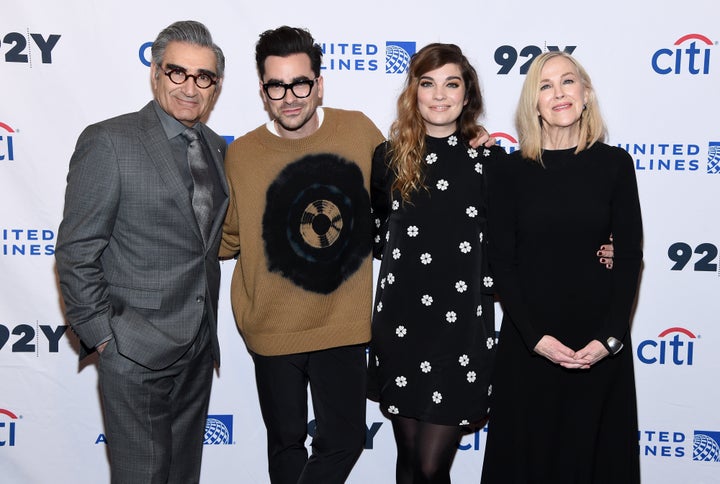“I would like to dedicate this to a very special someone in my life: David Rose.”
In a heart-melting 2018 episode of CBC’s hit “Schitt’s Creek,” the camera pans from guitar-cradling Patrick to David (played by Dan Levy), who is horrified by the concept of an open mic night and anxious that his boyfriend’s song will be terrible. After the first few chords of a criminally romantic cover of Tina Turner’s “Simply the Best,” however, David’s worry fades to bliss.
For queer viewers, watching same-sex relationships blossom on shows such as “Schitt’s Creek” is beautiful, but comes with anxiety. Too often, LGBTQ2 representations in pop culture either end in tragedy or farce, and parents (if not absent altogether) fail to affirm their kids’ gender identity or sexual orientation. Will David’s pansexuality become “too much” for his family? Will Patrick’s parents disown him?
But as David’s mother (played by Catherine O’Hara) whispers proudly, “My boy right now is being serenaded by his butter-voiced beau,” the audience can relax. Homosexuality isn’t the punchline to any jokes here. In presenting David’s pansexuality as the least exceptional thing about the outrageous Rose family, ”Schitt’s Creek” is wonderfully different.

‘An invitation to do better’
“′Schitt’s Creek’ and other affirming shows are an invitation to do better,” Angie Paterson, a Calgary mother of two, told HuffPost Canada. Paterson, whose name has been changed to protect the identity of her children, is bisexual and has been a vocal advocate for the LGBTQ2 community since before she had kids.
She’s worked hard to create an affirming, pride-filled home; her bumper sticker reads, “So gay I can’t even drive straight!” But when her daughter recently also came out as bisexual, she started the conversation imploring her mom not to be angry.
“The fear of rejection is so ingrained in our society that even in an expressly affirming and loving home, that fear was still present,” Paterson said.
She said this broke her heart, and thinks seeing more positive media depictions of LGBTQ2 families would help. “When the only references we have are centered on the negative reactions, we assume that is the only possible response. Being shown other responses can bring so much hope.”
Schitt’s Creek is a social phenomenon
“Schitt’s Creek” has earned a cult following by making viewers fall in love with characters who are initially unlikeable. Phrases like, “Ew, David” and “Very uninterested in that opinion” are already echoing in the halls of pop culture greatness.
But it was Dan Levy, the show’s creator and star, who transformed the show from quirky Canadian sitcom to social phenomenon.
In his acceptance speech for a GLAAD award honouring his LGBTQ2 advocacy, Levy said that as a young person, he thought he would have to keep being gay a secret because, “I didn’t have the security of seeing a lot of people like myself being celebrated in popular culture.” He wants the show to be a space where “acceptance incubates joy and creates a clarity that allows people to see themselves and each other more deeply.”
WATCH: How “Schitt’s Creek” is a win for queer representation. Story continues below.
Levy emphasized the high rates of suicide amongst sexual and gender minorities — he knows the wacky but warm world of ”Schitt’s Creek” is not the reality for so many. Indeed, 25 to 40 per cent of homeless youth in Canada are LGBTQ; family rejection is a primary cause. Levy doesn’t want to rainbow-wash the marginalization faced by queer and trans people every day.
“It’s fiction, yes,” he told the GLAAD audience. “But I’ve always been told to lead by example and this felt like a good place to start.”
Positive representations foster resilience
While TV is often seen as an escape from reality, Shelley Craig, a University of Toronto social work professor and the Canada Research Chair in Sexual and Gender Minority Youth, told HuffPost Canada that positive LGBTQ2 media representations help youth not only form their own identity but foster resilience.
Craig said she sees queer and trans youth “seeking out and finding affirming shows that really help them feel better about themselves, help them recharge — almost as a form of self-care.”
For instance, with over 122K re-tweets, this viral Belgian ad for coffee company Douwe Egbert shows that images of LGBTQ2-affirming families are resonating.
Craig is a fan of “Schitt’s Creek” herself, and has noticed youth using shows like this as a way to pave the way for coming out, maybe by asking their parents to watch the show with them or bringing it up in conversation.
“They’re using media to navigate the world around them. Shows like ′Schitt’s Creek’ are really doing that in a way that is super powerful,” Craig said.
Parents, too, need positive role models for what a queer family can look like. And Kiersten Mohr of Airdrie, Alta., mother of two and the president of the Airdrie Pride Society, appreciates that David’s sexuality isn’t a plot twist.
“It feels no different than any other relationship in the show,” Mohr told HuffPost Canada.
Mohr said she talks to many people who worry about the implications of coming out, and affirming media representations can give them a positive vision of what this could look like.
“We already know what homophobic families look like,” explains Calgary mom Angie Patterson. “It’s time to see what affirming families do.”
Also on HuffPost: